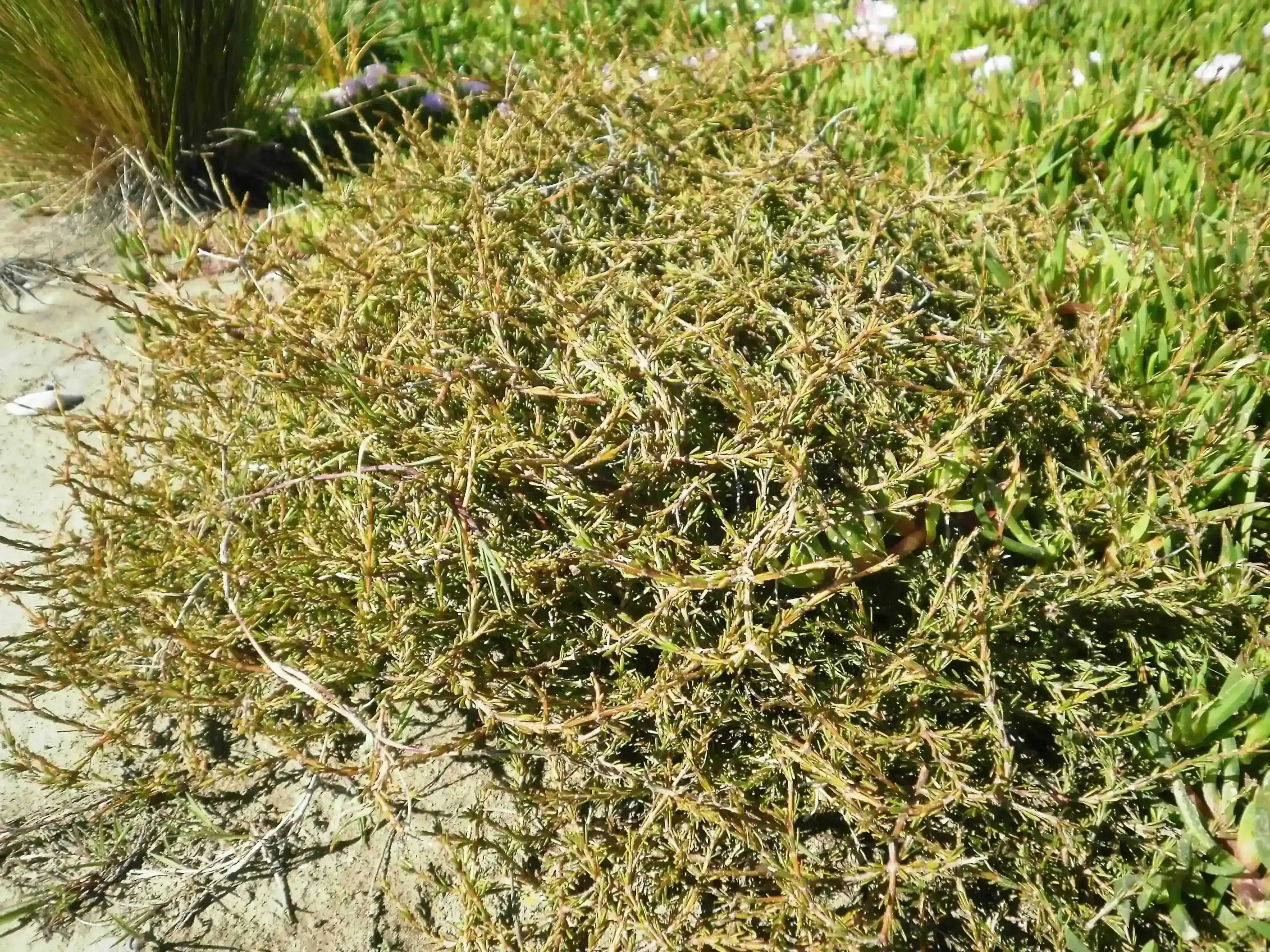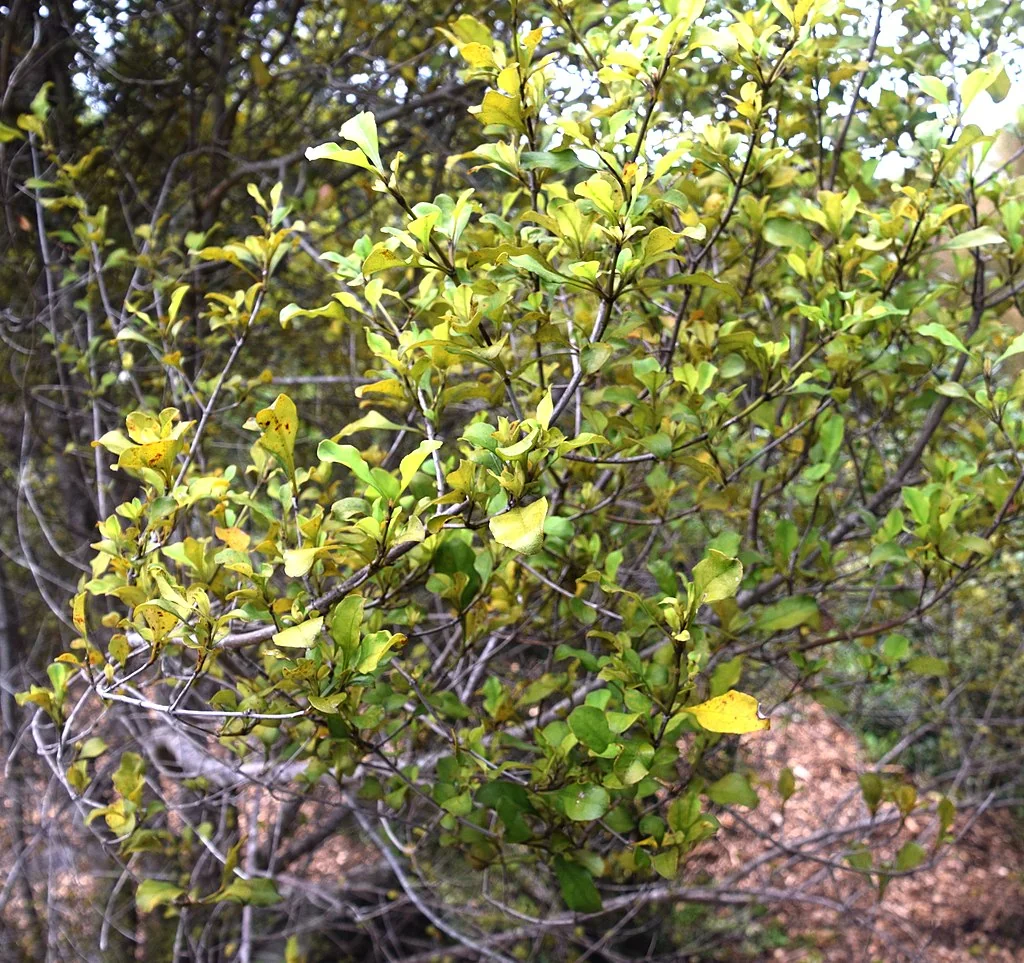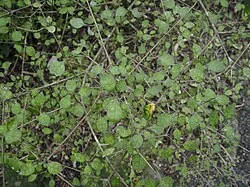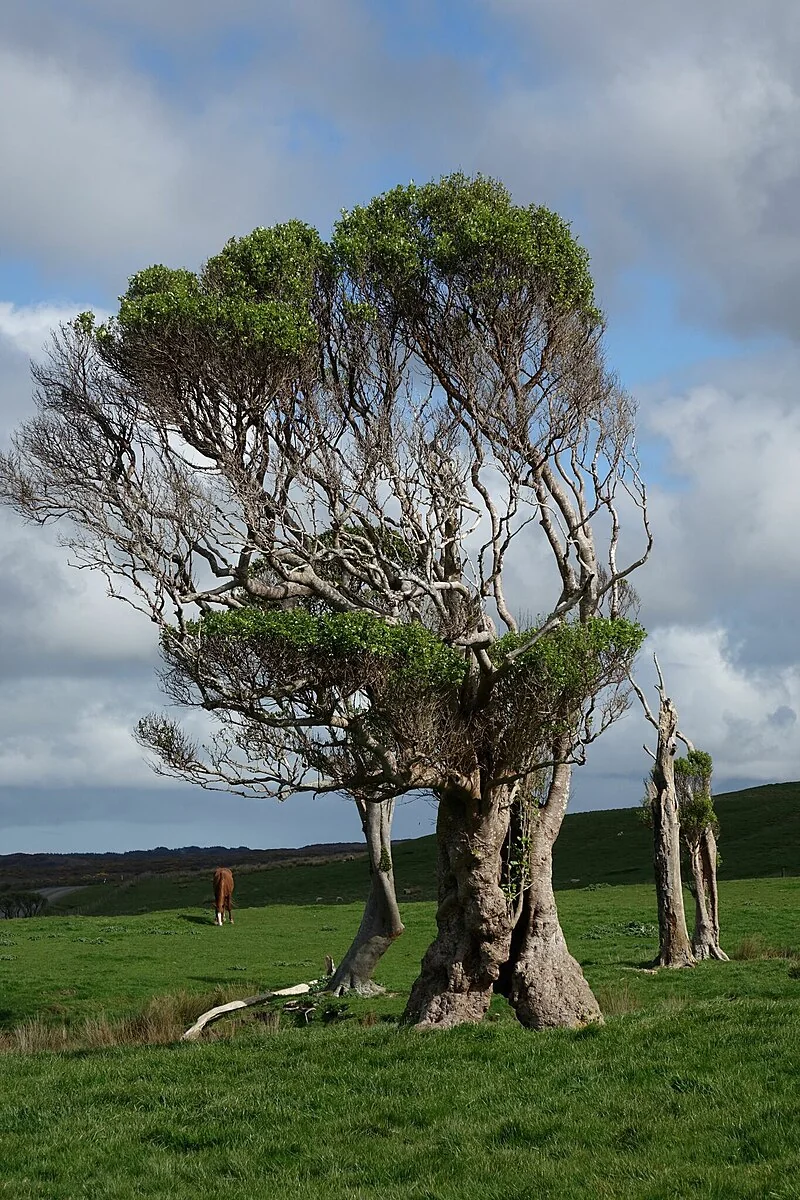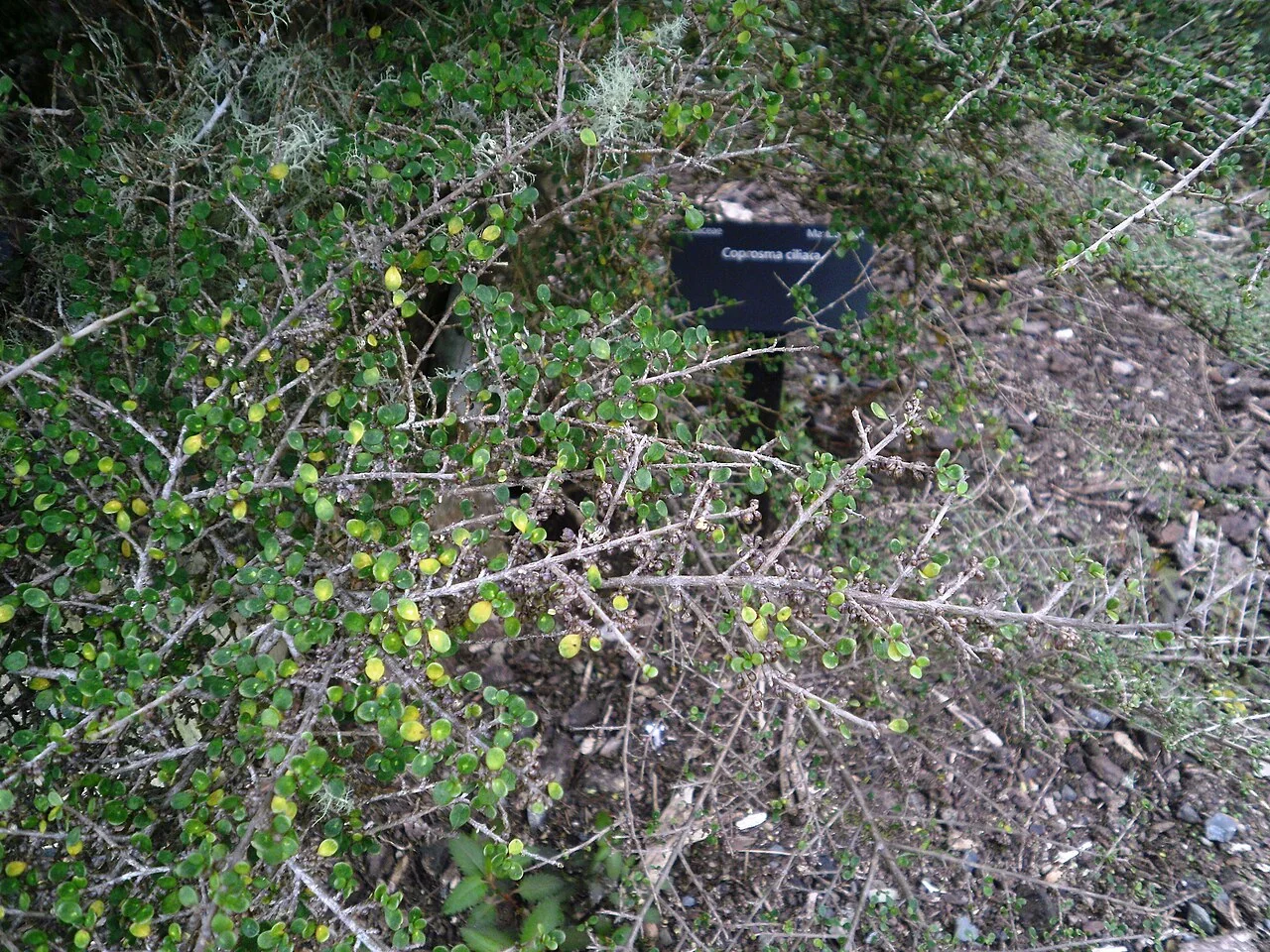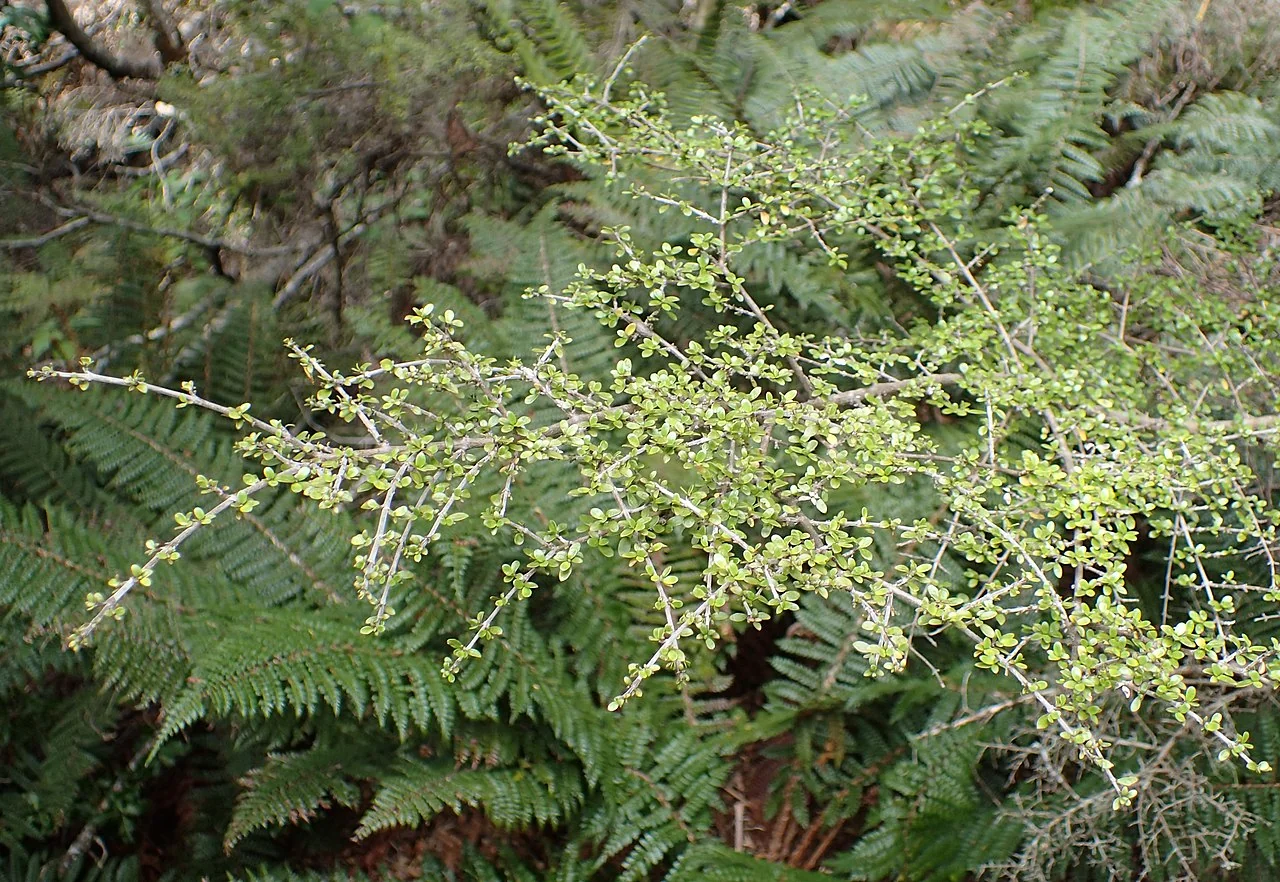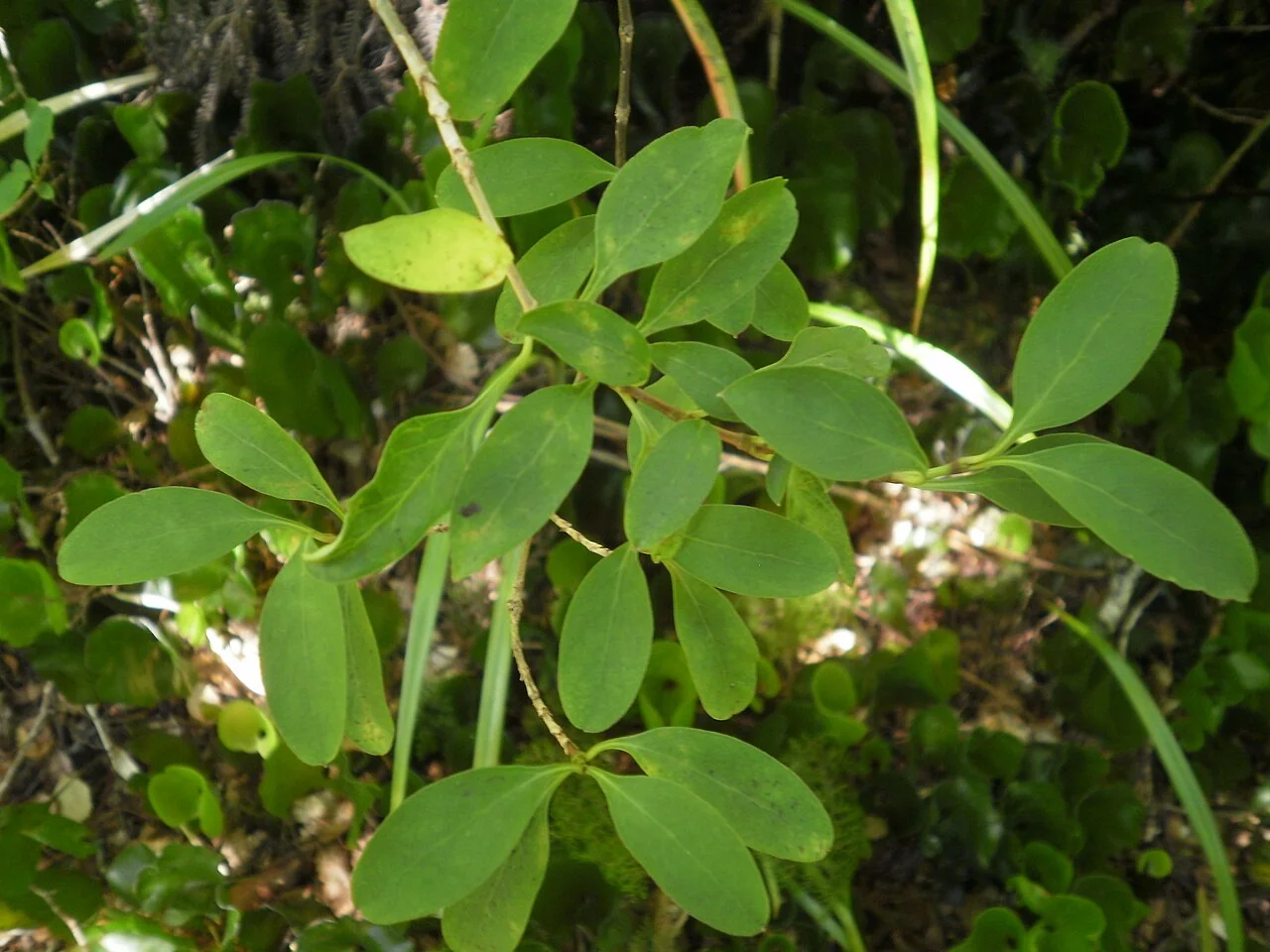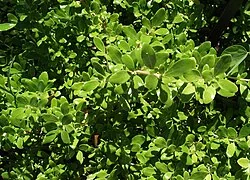
Kirk's Coprosma
Coprosma kirkii
Coprosma kirkii , commonly known as Kirk's Coprosma, is a remarkable natural hybrid between Coprosma acerosa and Coprosma repens that epitomizes New Zealand's unique botanical diversity. Named after renowned botanist Thomas Kirk, this low-growing evergreen groundcover shrub forms dense mats of small, glossy grey-green leaves that create an attractive carpet-like appearance. Typically reaching 40cm in height and spreading up to 1 meter wide, this hardy hybrid demonstrates exceptional tolerance to challenging growing conditions including coastal salt spray, drought, and poor soils. The small, leathery leaves are oval-shaped and closely set along spreading branches, providing year-round visual interest with their subtle texture and resilience. During flowering season, inconspicuous greenish flowers develop into small bluish-white berries that attract native birds, making this plant valuable for both ornamental and ecological purposes. Kirk's Coprosma excels as a coastal garden specimen, offering superior erosion control on banks and slopes while requiring minimal maintenance once established. Its natural hybrid vigor combines the best characteristics of both parent species, creating a versatile and dependable choice for sustainable New Zealand landscaping projects.

Plant Description
Coprosma kirkii is a vigorous, prostrate shrub that forms dense, interwoven mats with small, opposite leaves and rooting stems. Branches creep and layer naturally, allowing the plant to knit over rocks, banks and walls. The foliage is thick and leathery to resist salt and wind, with a neat, tidy appearance year-round. Tiny greenish flowers are followed by pale bluish to orange-red drupes that feed birds and add seasonal interest without creating litter.
In cultivation, the species typically reaches 30-50 cm in height and spreads to more than a metre, especially where stems can peg to the soil. Its hybrid origin confers strong vigour and adaptability, which shows in its ability to establish quickly in difficult positions where many other shrubs struggle.
Quick Facts
| Scientific Name | Coprosma Kirkii |
|---|---|
| Common Names | Kirk's Coprosma, Groundcover Coprosma |
| Family | Rubiaceae (Coffee family) |
| Plant Type | Evergreen shrub/groundcover hybrid |
| Height | 40cm (up to 50cm) |
| Spread | 1 m (can reach 1.5 m) |
| Growth Habit | Low-growing, dense mat-forming, prostrate |
| Foliage | Small, oval, glossy grey-green, leathery texture |
| Flowers | Inconspicuous, greenish, small |
| Flowering Time | Spring-Summer (October-January) |
| Fruit | Small bluish-white berries |
| Parent Species | Coprosma acerosa ÃÆÃ'Ãâ '- Coprosma repens |
| Origin | New Zealand (North Island hybrid) |
| Conservation Status | Not Threatened (hybrid) |
| Water Needs | Low - excellent drought tolerance once established |
| Light | Full sun to partial shade |
| Frost Tolerance | Moderate - hardy to -2ÃÆÃ'" ¡°C when established |
| Salt Tolerance | Excellent - ideal for coastal conditions |
| Growth Rate | Fast - establishes quickly |
| Lifespan | Long-lived evergreen (15+ years) |
| Climate Cities | Suitable for Auckland, Tauranga, Wellington, Nelson, Christchurch, Napier |
| Soil Tolerance | Wide range - sandy, rocky, poor soils, well-drained |
| Uses | Groundcover, erosion control, coastal gardens, rockeries, bank stabilization |
Climate Best Suited to
Cool to mild temperate climates; tolerates frost and wind; copes with coastal influence with some shelter.
Regional Suitability
| City | Climate Suitability |
|---|---|
| Whangārei | Ideal |
| Auckland | Ideal |
| Hamilton | Ideal |
| Tauranga | Ideal |
| Rotorua | Ideal |
| Gisborne | Ideal |
| New Plymouth | Ideal |
| Napier | Ideal |
| Whanganui | Ideal |
| Palmerston North | Ideal |
| Wellington | Ideal |
| Nelson | Ideal |
| Christchurch | Ideal |
| Dunedin | Ideal |
| Invercargill | Ideal |
Natural Habitat
Subalpine to montane scrub and open forest margins, often on exposed, stony sites with periodic drought and strong winds. In coastal districts, naturalised and planted populations thrive on dunes, headlands and cliff tops where salt spray and free-draining soils select for tough, low-growing forms. The creeping habit allows stems to root where nodes contact the soil, creating effective ground binding on banks and cut-faces.
Plant Conservation
Not threatened in cultivation; wild occurrences reflect the distribution of parent species and local disturbance regimes. Because it establishes readily from cuttings and transplants well, it is commonly used in coastal restoration where a fast, resilient groundcover is required to out-compete invasive grasses and bind sandy substrates.
How to Grow
Planting Guide
Best Planting Practices
Space plants 60-100 cm apart for a continuous groundcover, closer on steep banks. On slopes, plant slightly above grade and firm well to prevent rocking. Peg or pin young stems onto bare soil to encourage layering and rapid infill.
For containers and walls, allow stems to cascade; trim runners periodically to maintain the desired outline without losing the dense, carpeted look.
Ecology
Fruiting drupes are taken by small birds which assist local dispersal. The tight mat and layered stems provide niche habitat and basking edges for skinks while suppressing weeds. On sandy soils, the extensive surface rooting helps stabilise loose substrates and reduce erosion from wind and runoff.
Uses
Bank binding and slope stabilisation, weed-suppressing groundcover for sunny coastal gardens, softening for retaining walls and rockeries, and a resilient filler between shrubs in exposed sites. Its neat habit also makes an excellent, low-maintenance alternative to exotic groundcovers in coastal plantings.
Landscaping Ideas
Integrate with coastal species such as Muehlenbeckia complexa , Hebe elliptica and hardy grasses for a layered, wind-tolerant palette. Use as a foreground matrix around feature plants and allow it to cascade over the edges of steps or walls for a natural, knitted look.
Seasonal Care
Spring
Lightly tip-prune to encourage branching after the last frost. Check pegs and re-position stems to fill gaps.
Summer
Water deeply but infrequently in prolonged dry spells until well established. In coastal gardens, rinse dust and salt with occasional hose-down to keep foliage glossy.
Autumn
Light trim to keep off paths and refresh the outline; firm any lifted plants after heavy rain and top up a thin gravel mulch to suppress weeds.
Pruning
Pruning Techniques
Trim long runners a few times a year to maintain a tidy outline and to encourage denser branching. Avoid cutting back to bare, old wood; instead, stagger small trims to preserve the carpet effect and keep edges crisp along paths.
How to Grow Kirk's Coprosma
Kirk's Coprosma grows best when you match its natural habitat: prepare well-drained soil, get the light right, water steadily, and protect from extremes during establishment. Dig wide planting holes, set the crown at original depth, water to settle, and mulch with coarse organic matter to conserve moisture while keeping the stem base dry. Feed lightly in spring; heavy nitrogen is unnecessary and can weaken growth.
Seed
Sow fresh, viable seed on a free-draining mix, cover lightly with fine grit, and keep evenly moist in bright light out of harsh sun. Germination timing varies; prick out once roots hold the media and harden off gradually.
Division
Where the species permits, divide robust clumps in early spring as new growth begins. Replant divisions with several shoots into fresh mix, water thoroughly, and maintain steady moisture until re-established.
Cuttings
For shrubs and many perennials, strike semi-hardwood cuttings in late spring to summer in a coarse, free-draining propagation mix under gentle bottom heat and high humidity. Reduce leaf area, ventilate progressively as roots develop, and pot on before planting out.
After-Care
Maintain an open mulch, irrigate during drought in the first season, and prune or tidy according to the species to build a resilient framework. Adjust shade, wind exposure and watering to prevent stress, and refresh mulch annually for long-term performance.
Pests and Diseases
Common Problems and Solutions
Generally trouble-free. In enclosed, dry sites, scale or mealybug may appear on older stems; encourage airflow and wash off with a gentle soap spray if needed. Snails can nick tender tips-use cultural controls and hand-pick where practical. Waterlogging predisposes roots to rot; remedy by improving drainage and avoiding thick, moisture-holding mulches at the crown.
Cultural Significance
Traditional Uses and Values
While Coprosma kirkii is a natural hybrid without specific traditional Māori uses documented separately from its parent species, it represents an important connection to New Zealand's broader cultural landscape through its relationship to the Coprosma genus and its namesake, botanist Thomas Kirk.
Thomas Kirk (1828-1898) was a significant figure in New Zealand botanical exploration and documentation, contributing extensively to the understanding of New Zealand's native flora during the late 19th century. His work helped establish the scientific foundation for recognizing and preserving New Zealand's unique plant heritage, making plants bearing his name living memorials to early botanical research in the country.
Within the broader context of Coprosma species, the genus holds cultural significance for Māori, who traditionally utilized the fruits of larger Coprosma species as food sources, particularly the orange berries that were consumed by children and valued for their nutritional properties. Some Coprosma species also provided materials for traditional dyeing processes, contributing natural pigments for colouring flax fibers.
In contemporary New Zealand, Kirk's Coprosma serves as an excellent ambassador for native plant gardening and coastal restoration efforts. Its hybrid vigor and adaptability make it valuable for ecological restoration projects that help preserve coastal ecosystems while honoring the scientific legacy of early botanical exploration. The plant's success in challenging environments embodies the resilience and adaptability that characterizes much of New Zealand's unique flora.
Bonus Tip
Expert Growing Advice
Pin flexible stems with biodegradable U-shaped pegs onto bare soil to encourage rooting at nodes, then remove the pegs once anchored. This speeds coverage on banks, improves erosion control and creates an even, seamless carpet.
